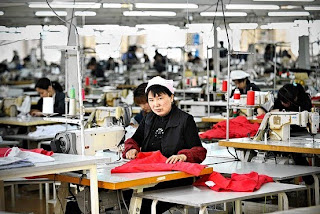Rising labor costs in China are forcing U.S. apparel and accessories retailers, such as AnnTaylor Stores Corp. and Coach Inc., to consider relocating at least some of their production to countries with cheaper work forces. But doing so could risk increasing other expenses, such as shipping.
"We are looking to move production into lower-cost geographies, most notably Vietnam and India," Mike Devine, Coach's chief financial officer, said at a conference last week. The luxury-handbag retailer already produces goods in those countries, but plans to increase its presence in both of them.
Guess Inc. is thinking along similar lines. Dennis Secor, the fashion brand's chief financial officer, said in an interview that Guess is looking to build its production capabilities in Vietnam, Cambodia and Indonesia.
Recent minimum-wage increases have pushed up Chinese labor costs by 5% to 15% on average this year, said Rick Darling, president of LF USA, a unit of Hong Kong-based Li & Fung Ltd., which acts as a go-between for retailers and their webs of suppliers. In the southern coastal province of Guangdong, one of a handful of hubs for apparel and accessories makers, the monthly minimum wage rose on average by more than 20%, effective May 1, the firm said.
The gains come as Chinese workers more broadly have been securing wage increases, partly through labor disputes. In addition, their government has sought to steer manufacturing away from labor-intensive, low-technology industries, such as textiles, into more-sophisticated products, such as electronics devices.
The higher pay has boosted the purchasing power of Chinese consumers, but is pressuring U.S. apparel chains and others that rely on low-cost labor. Along with rising prices of cotton and transportation, the wage increases could push apparel retailers' costs in China up 2% to 5% a year, said Mr. Darling.
That prospect has sent retailers scrambling to find new ways to reduce production costs. If they fail, they will have to absorb the higher costs, battering their margins, which have just begun to recover from the recession. Or, they could pass the costs along to consumers, a risky move at a time when shoppers are beginning to regain some of their appetite for spending.
"It is a really bad time for labor costs to be rising," said Jeremy Rubman, retail strategist at consulting firm Kurt Salmon Associates. "Nobody wants to alienate the consumer that's finally coming back."
J.C. Penney Co. said recently that its apparel makers have been leaving China for Indonesia, Vietnam, India and Bangladesh for the past five years. Those countries "have a better cost base from a labor standpoint," said Jim Kenney, Penney's senior vice president of corporate strategy.
AnnTaylor Chief Financial Officer Michael Nicholson said his company has been working with its top 15 suppliers, which manufacture about 60% to 65% of its products, to relocate to lower-cost countries. But Mr. Nicholson added a caveat: the moves will only happen "once they prove that the quality is there."
Indeed, for the money, the quality of Chinese-made goods is tough to match, and labor is just one of the costs of production. Others include the costs of raw materials like textiles, production facilities, transportation and quality control and training.
The skills of China's labor force and its familiarity with the ways and expectations of U.S. companies, exceed that of any other Asian country, said Mr. Rubman, the retail strategist.
Guangdong province is known for its footwear and handbag work, which is difficult to replicate. Moreover, labor typically accounts for between 15% and 22% of the total cost of a garment, while fabric and logistics can account for as much as 60%, according to Hana Ben-Shabat, a partner in the retail practice of consulting firm A.T. Kearney.
Moving production to Bangladesh to take advantage of that nation's lower labor costs could raise transportation costs, in part because the country is off the beaten path for shipping lines, said Ms. Ben-Shabat.
Vietnam has a big labor pool, but textiles aren't as available there as in China, meaning retailers would have to ship in fabrics, said Andrew Jassin, managing director of fashion consulting firm Jassin Consulting Group.
"The only replacement for China is China," said Li & Fung's Mr. Darling, adding that his firm is scouting production possibilities in northern and western China. Since those areas have played only a minor role in the country's manufacturing boom, wages there remain relatively low.
SOURCE: The Wall Street Journal
ALSO SEE: Production Costs Rise - Who will pay in this tough economy?


No comments:
Post a Comment